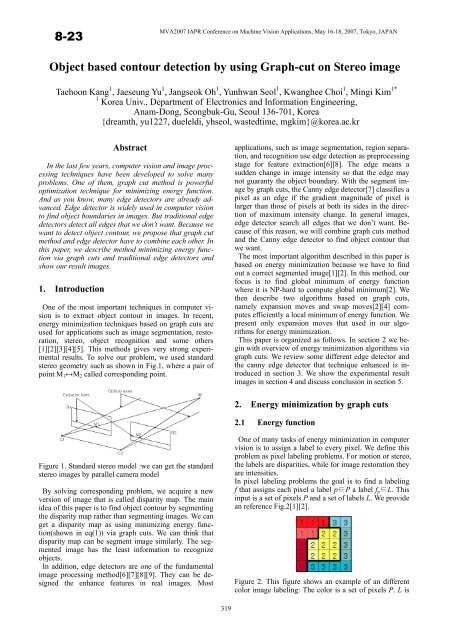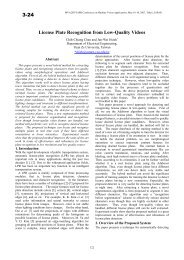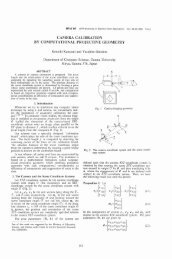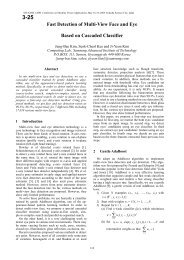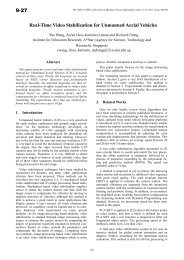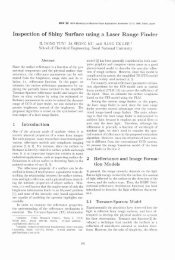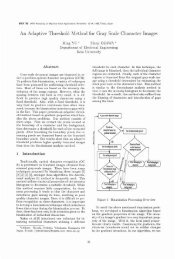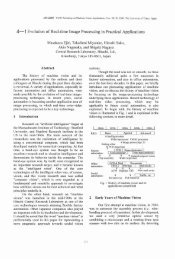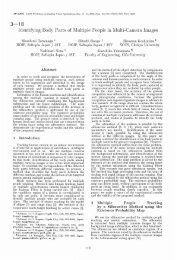Object based contour detection by using Graph-cut on Stereo image
Object based contour detection by using Graph-cut on Stereo image
Object based contour detection by using Graph-cut on Stereo image
Create successful ePaper yourself
Turn your PDF publications into a flip-book with our unique Google optimized e-Paper software.
8-23<br />
MVA2007 IAPR C<strong>on</strong>ference <strong>on</strong> Machine Visi<strong>on</strong> Applicati<strong>on</strong>s, May 16-18, 2007, Tokyo, JAPAN<br />
<str<strong>on</strong>g>Object</str<strong>on</strong>g> <str<strong>on</strong>g>based</str<strong>on</strong>g> <str<strong>on</strong>g>c<strong>on</strong>tour</str<strong>on</strong>g> <str<strong>on</strong>g>detecti<strong>on</strong></str<strong>on</strong>g> <str<strong>on</strong>g>by</str<strong>on</strong>g> <str<strong>on</strong>g>using</str<strong>on</strong>g> <str<strong>on</strong>g>Graph</str<strong>on</strong>g>-<str<strong>on</strong>g>cut</str<strong>on</strong>g> <strong>on</strong> <strong>Stereo</strong> <strong>image</strong><br />
Taeho<strong>on</strong> Kang 1 , Jaeseung Yu 1 , Jangseok Oh 1 , Yunhwan Seol 1 , Kwanghee Choi 1 , Mingi Kim 1*<br />
1 Korea Univ., Department ofElectr<strong>on</strong>ics and Informati<strong>on</strong> Engineering,<br />
Anam-D<strong>on</strong>g, Se<strong>on</strong>gbuk-Gu, Seoul 136-701, Korea<br />
{dreamth, yu1227, dueleldi, yhseol, wastedtime, mgkim}@korea.ac.kr<br />
Abstract<br />
In the last few years, computer visi<strong>on</strong> and <strong>image</strong> processing<br />
techniques have been developed to solve many<br />
problems. One of them, graph <str<strong>on</strong>g>cut</str<strong>on</strong>g> method is powerful<br />
optimizati<strong>on</strong> technique for minimizing energy functi<strong>on</strong>.<br />
And as you know, many edge detectors are already advanced.<br />
Edge detector is widely used in computer visi<strong>on</strong><br />
to find object boundaries in <strong>image</strong>s. But traditi<strong>on</strong>al edge<br />
detectors detect all edges that we d<strong>on</strong>’t want. Because we<br />
want to detect object <str<strong>on</strong>g>c<strong>on</strong>tour</str<strong>on</strong>g>, we propose that graph <str<strong>on</strong>g>cut</str<strong>on</strong>g><br />
method and edge detector have to combine each other. In<br />
this paper, we describe method minimizing energy functi<strong>on</strong><br />
via graph <str<strong>on</strong>g>cut</str<strong>on</strong>g>s and traditi<strong>on</strong>al edge detectors and<br />
show our result <strong>image</strong>s.<br />
1. Introducti<strong>on</strong><br />
One of the most important techniques in computer visi<strong>on</strong><br />
is to extract object <str<strong>on</strong>g>c<strong>on</strong>tour</str<strong>on</strong>g> in <strong>image</strong>s. In recent,<br />
energy minimizati<strong>on</strong> techniques <str<strong>on</strong>g>based</str<strong>on</strong>g> <strong>on</strong> graph <str<strong>on</strong>g>cut</str<strong>on</strong>g>s are<br />
used for applicati<strong>on</strong>s such as <strong>image</strong> segmentati<strong>on</strong>, restorati<strong>on</strong>,<br />
stereo, object recogniti<strong>on</strong> and some others<br />
[1][2][3][4][5]. This methods gives very str<strong>on</strong>g experimental<br />
results. To solve our problem, we used standard<br />
stereo geometry such as shown in Fig.1, where a pair of<br />
point M 1 M 2 called corresp<strong>on</strong>ding point.<br />
applicati<strong>on</strong>s, such as <strong>image</strong> segmentati<strong>on</strong>, regi<strong>on</strong> separati<strong>on</strong>,<br />
and recogniti<strong>on</strong> use edge <str<strong>on</strong>g>detecti<strong>on</strong></str<strong>on</strong>g> as preprocessing<br />
stage for feature extracti<strong>on</strong>[6][8]. The edge means a<br />
sudden change in <strong>image</strong> intensity so that the edge may<br />
not guaranty the object boundary. With the segment <strong>image</strong><br />
<str<strong>on</strong>g>by</str<strong>on</strong>g> graph <str<strong>on</strong>g>cut</str<strong>on</strong>g>s, the Canny edge detector[7] classifies a<br />
pixel as an edge if the gradient magnitude of pixel is<br />
larger than those of pixels at both its sides in the directi<strong>on</strong><br />
of maximum intensity change. In general <strong>image</strong>s,<br />
edge detector search all edges that we d<strong>on</strong>’t want. Because<br />
of this reas<strong>on</strong>, we will combine graph <str<strong>on</strong>g>cut</str<strong>on</strong>g>s method<br />
and the Canny edge detector to find object <str<strong>on</strong>g>c<strong>on</strong>tour</str<strong>on</strong>g> that<br />
we want.<br />
The most important algorithm described in this paper is<br />
<str<strong>on</strong>g>based</str<strong>on</strong>g> <strong>on</strong> energy minimizati<strong>on</strong> because we have to find<br />
out a correct segmented <strong>image</strong>[1][2]. In this method, our<br />
focus is to find global minimum of energy functi<strong>on</strong><br />
where it is NP-hard to compute global minimum[2]. We<br />
then describe two algorithms <str<strong>on</strong>g>based</str<strong>on</strong>g> <strong>on</strong> graph <str<strong>on</strong>g>cut</str<strong>on</strong>g>s,<br />
namely expansi<strong>on</strong> moves and swap moves[2][4] computes<br />
efficiently a local minimum of energy functi<strong>on</strong>. We<br />
present <strong>on</strong>ly expansi<strong>on</strong> moves that used in our algorithms<br />
for energy minimizati<strong>on</strong>.<br />
This paper is organized as follows. In secti<strong>on</strong> 2 we begin<br />
with overview of energy minimizati<strong>on</strong> algorithms via<br />
graph <str<strong>on</strong>g>cut</str<strong>on</strong>g>s. We review some different edge detector and<br />
the canny edge detector that technique enhanced is introduced<br />
in secti<strong>on</strong> 3. We show the experimental result<br />
<strong>image</strong>s in secti<strong>on</strong> 4 and discuss c<strong>on</strong>clusi<strong>on</strong> in secti<strong>on</strong> 5.<br />
2. Energy minimizati<strong>on</strong> <str<strong>on</strong>g>by</str<strong>on</strong>g> graph <str<strong>on</strong>g>cut</str<strong>on</strong>g>s<br />
2.1 Energy functi<strong>on</strong><br />
Figure 1. Standard stereo model :we can get the standard<br />
stereo <strong>image</strong>s <str<strong>on</strong>g>by</str<strong>on</strong>g> parallel camera model<br />
By solving corresp<strong>on</strong>ding problem, we acquire a new<br />
versi<strong>on</strong> of <strong>image</strong> that is called disparity map. The main<br />
idea of this paper is to find object <str<strong>on</strong>g>c<strong>on</strong>tour</str<strong>on</strong>g> <str<strong>on</strong>g>by</str<strong>on</strong>g> segmenting<br />
the disparity map rather than segmenting <strong>image</strong>s. We can<br />
get a disparity map as <str<strong>on</strong>g>using</str<strong>on</strong>g> minimizing energy functi<strong>on</strong>(shown<br />
in eq(1)) via graph <str<strong>on</strong>g>cut</str<strong>on</strong>g>s. We can think that<br />
disparity map can be segment <strong>image</strong> similarly. The segmented<br />
<strong>image</strong> has the least informati<strong>on</strong> to recognize<br />
objects.<br />
In additi<strong>on</strong>, edge detectors are <strong>on</strong>e of the fundamental<br />
<strong>image</strong> processing method[6][7][8][9]. They can be designed<br />
the enhance features in real <strong>image</strong>s. Most<br />
One of many tasks of energy minimizati<strong>on</strong> in computer<br />
visi<strong>on</strong> is to assign a label to every pixel. We define this<br />
problem as pixel labeling problems. For moti<strong>on</strong> or stereo,<br />
the labels are disparities, while for <strong>image</strong> restorati<strong>on</strong> they<br />
are intensities.<br />
In pixel labeling problems the goal is to find a labeling<br />
f that assigns each pixel a label pP a label f p L. This<br />
input is a set of pixels P and a set of labels L. We provide<br />
an reference Fig.2[1][2].<br />
Figure 2. This figure shows an example of an different<br />
color <strong>image</strong> labeling: The color is a set of pixels P. L is<br />
319
label assingning L p {1,2,3}. This labeling means segment<br />
<strong>image</strong> that we want[2][4].<br />
We can formulate a standard form of the energy functi<strong>on</strong><br />
to solve this pixel labeling problem[1][2][3][4][5].<br />
The form of energy functi<strong>on</strong> is<br />
E( f ) E ( f ) E ( f )<br />
E data (f) and E smooth (f) can be also represented as follows<br />
E ( f ) <br />
This functi<strong>on</strong> includes a variety of different c<strong>on</strong>cept such<br />
as first-order Markov Random Fields. D p (f p ) is a data<br />
penalty functi<strong>on</strong> and it means that how well assign a label<br />
f p to a pixel p given the observed data. V p,q (f p , f q )<br />
penalizing between neighboring pixels p, qN is spatial<br />
smoothness term. N is the set of neighboring pixels of<br />
left <strong>image</strong>. V can be separated from metric and<br />
semi-metric. For any labels , , L<br />
V(, ) = 0 = (2)<br />
V(, ) = V(, ) (3)<br />
V(, ) V(, ) + V(, ) (4) <br />
If V satisfy (2),(3) and (4), V is metric <strong>on</strong> the space of<br />
Label L. Also V is called a semi-metric if it satisfies <strong>on</strong>ly<br />
(2),(3)[2]. We can specify this equati<strong>on</strong> <str<strong>on</strong>g>by</str<strong>on</strong>g> potts model as<br />
follows.<br />
E ( f ) <br />
<br />
pP<br />
<br />
pL<br />
data<br />
D<br />
D<br />
p<br />
p<br />
( f<br />
( f<br />
p<br />
p<br />
) <br />
) <br />
smooth<br />
<br />
V<br />
p.<br />
qN<br />
<br />
V<br />
p . qN<br />
p , q<br />
( f<br />
T<br />
, f<br />
Here T() is 1 if its argument is true and 0 otherwise[1][3].<br />
Our goal is to find labeling f for local<br />
minimum to minimize energy functi<strong>on</strong>(1). We can also<br />
use -expansi<strong>on</strong> move algorithm to generate labeling f.<br />
This is a str<strong>on</strong>g move allowing many pixels to change<br />
their labels to simultaneously. Given a label ,<br />
-expansi<strong>on</strong> is a move from a partiti<strong>on</strong> P(labeling f) to a<br />
new partiti<strong>on</strong> P’ if P P ’ and P l ’ P l for any label l <br />
[2].<br />
In pixel labeling problem, We have to find f that minimize<br />
energy functi<strong>on</strong>. To solve this problem, We can use<br />
graph <str<strong>on</strong>g>cut</str<strong>on</strong>g> method.<br />
p<br />
f<br />
p , q<br />
(<br />
p q<br />
)<br />
q<br />
)<br />
<br />
f<br />
(1)<br />
thickness.<br />
As menti<strong>on</strong>ed above, graph <str<strong>on</strong>g>cut</str<strong>on</strong>g> is used for finding f to<br />
minimize energy functi<strong>on</strong>. A weighted graph G = V,<br />
Ehave two special nodes that are called terminals. V is<br />
the set of vertices and E is the set of edge. The terminals<br />
are {s, t} that means source and sink. In this paper, the<br />
node means pixels. In Fig.3 we show a example of graph<br />
<str<strong>on</strong>g>cut</str<strong>on</strong>g> having two terminals (source and sink)[1].<br />
In the graph, edge has two types called n-link and t-link.<br />
All such edges are assigned n<strong>on</strong>negative weight and cost.<br />
n-links c<strong>on</strong>nect pairs of neighboring pixels in the graph.<br />
So the cost of n-link is a penalty for disc<strong>on</strong>tinuity and is<br />
derived from V (smoothness term) in (1). t-link c<strong>on</strong>nect<br />
pixels with terminals or labels the cost of t-link is a penalty<br />
for assigning the corresp<strong>on</strong>ding label to the pixel<br />
and is derived from D (data term) in (1).<br />
We have to find a minimum <str<strong>on</strong>g>cut</str<strong>on</strong>g> that has the minimum<br />
cost am<strong>on</strong>g all <str<strong>on</strong>g>cut</str<strong>on</strong>g>s in the graph. In Fig.3 green line is a<br />
<str<strong>on</strong>g>cut</str<strong>on</strong>g> that means minimum cost. The <str<strong>on</strong>g>cut</str<strong>on</strong>g> C={S,T} is a partiti<strong>on</strong><br />
of the vertices in V into two disjoint set S and T<br />
such that s S and tT. The minimum <str<strong>on</strong>g>cut</str<strong>on</strong>g> problem is<br />
derived from solving <str<strong>on</strong>g>by</str<strong>on</strong>g> finding a maximum flow from<br />
the source s to the sink t[1][5].<br />
We briefly summarized to minimize Energy functi<strong>on</strong> <str<strong>on</strong>g>by</str<strong>on</strong>g><br />
graph <str<strong>on</strong>g>cut</str<strong>on</strong>g>. This theory is a powerful method to find disparity<br />
map or segment <strong>image</strong>. The <strong>image</strong> is used for<br />
extracting object <str<strong>on</strong>g>c<strong>on</strong>tour</str<strong>on</strong>g> <str<strong>on</strong>g>by</str<strong>on</strong>g> combining edge detector.<br />
3. Edge detector<br />
3.1 Introducti<strong>on</strong> to edge detectors<br />
Algorithms to combine edge <str<strong>on</strong>g>detecti<strong>on</strong></str<strong>on</strong>g> and <strong>image</strong> segmentati<strong>on</strong><br />
have been studied for many years. The edge<br />
<str<strong>on</strong>g>detecti<strong>on</strong></str<strong>on</strong>g> is <str<strong>on</strong>g>by</str<strong>on</strong>g> far the most comm<strong>on</strong> approach for meaningful<br />
disc<strong>on</strong>tinuities in intensity value. The first- or<br />
sec<strong>on</strong>d- derivative that means the gradient is useful for<br />
detecting edge <strong>on</strong> <strong>image</strong>. The edge detector performs a<br />
simple 2-D spatial gradient measurement <str<strong>on</strong>g>by</str<strong>on</strong>g> <str<strong>on</strong>g>using</str<strong>on</strong>g> vector<br />
functi<strong>on</strong> of 2-D gradient of <strong>image</strong> intensities[6][7].<br />
f<br />
f<br />
<br />
<br />
f x <br />
Gy<br />
<br />
<br />
y<br />
<br />
(5)<br />
G x<br />
2<br />
2.2 <str<strong>on</strong>g>Graph</str<strong>on</strong>g> <str<strong>on</strong>g>cut</str<strong>on</strong>g><br />
We can present a simple equati<strong>on</strong> of the magnitude of the<br />
gradient[9].<br />
G <br />
2<br />
G x<br />
G y<br />
The angle of orientati<strong>on</strong> of the edge that means the directi<strong>on</strong><br />
of the gradient in given <str<strong>on</strong>g>by</str<strong>on</strong>g><br />
Figure 3. A <str<strong>on</strong>g>cut</str<strong>on</strong>g> <strong>on</strong> graph G. Red and blue line is n-link.<br />
Yellow line is t-link. Edge costs are reflected <str<strong>on</strong>g>by</str<strong>on</strong>g> line’s<br />
tan<br />
1<br />
G<br />
<br />
G<br />
y<br />
x<br />
<br />
<br />
<br />
There are many detectors for detecting edge such as<br />
Sobel, Prewitt and Roberts detector. In Fig.4 we can detect<br />
edges through the use masks of the first- derivatives<br />
they implement[6].<br />
320
Prewitt mask<br />
-1 -1 -1 -1 0 1<br />
0 0 0 -1 0 1<br />
1 1 1 -1 0 1<br />
G x<br />
G y<br />
Sobel mask<br />
-1 -2 -1 -1 0 1<br />
0 0 0 -2 0 2<br />
1 2 1 -1 0 1<br />
G x<br />
G y<br />
Roberts mask<br />
-1 0 0 -1<br />
0 1 1 0<br />
G x<br />
G y<br />
Figure 4. Masks of some edge detector. G x and G y are the<br />
first derivatives of gradient vector.<br />
3.2 Canny edge detector<br />
The Canny edge detector developed <str<strong>on</strong>g>by</str<strong>on</strong>g> John Canny [7]<br />
is the optimal detector used around the world. This edge<br />
detector is <str<strong>on</strong>g>based</str<strong>on</strong>g> <strong>on</strong> detecting at the zero-crossing of the<br />
sec<strong>on</strong>d directi<strong>on</strong>al derivative of the smoothed <strong>image</strong>. The<br />
procedure of the Canny edge detector was as follows [6]:<br />
1. We can use an appropriate 2-D Gaussian filter<br />
to make smoothed <strong>image</strong>.<br />
2. In smoothed <strong>image</strong> we have to compute the<br />
gradient directi<strong>on</strong> and magnitude at each point.<br />
An edge point is defined that strength of the<br />
point is locally maximum in the directi<strong>on</strong> of the<br />
gradient.<br />
3. Perform n<strong>on</strong>-maximal suppressi<strong>on</strong>. The edge<br />
point determined above rise to ridges in the<br />
gradient magnitude <strong>image</strong>. Tracking the top of<br />
the ridges and set to zero all pixels that are not<br />
<strong>on</strong> the ridge top to make a thin line in the output<br />
<strong>image</strong>.<br />
4. The ridge pixels are thresholded <str<strong>on</strong>g>by</str<strong>on</strong>g> <str<strong>on</strong>g>using</str<strong>on</strong>g> T1<br />
and T2 with T1
We apply the Canny edge detector to output <strong>image</strong> <str<strong>on</strong>g>by</str<strong>on</strong>g><br />
graph <str<strong>on</strong>g>cut</str<strong>on</strong>g>s in order to find object boundary. Fig.6 shows<br />
the difference of the result in the same c<strong>on</strong>diti<strong>on</strong> of parameter.<br />
In this Fig.6 we use the same parameter of<br />
T1=0.05 and T2=0.1. As menti<strong>on</strong>ed above the T1, T2<br />
means threshold values. The parameters was obtained <str<strong>on</strong>g>by</str<strong>on</strong>g><br />
repeated experiments and can adopt the optimized results.<br />
The left <strong>image</strong>s have edges of all objects. We d<strong>on</strong>’t need<br />
all edges when we detect or track objects. Hence, we<br />
readjust parameters, T1 and T2 to show the result of object<br />
boundary we want.<br />
edge detector performs good results for finding object<br />
boundary. Our results show the general boundary of the<br />
objects. However, the <str<strong>on</strong>g>c<strong>on</strong>tour</str<strong>on</strong>g> extracted <str<strong>on</strong>g>by</str<strong>on</strong>g> our segmented<br />
<strong>image</strong> of Fig.6 is not matched with the exact<br />
boundary. In additi<strong>on</strong>, our final goal is to extract<br />
boundaries of each object we want to find. For instance,<br />
if we want to find <strong>on</strong>ly the boundary of camera in Tsukuba<br />
<strong>image</strong>, our algorithm is limited. To improve the<br />
more accurate boundary, our future works will use snake<br />
algorithms of active <str<strong>on</strong>g>c<strong>on</strong>tour</str<strong>on</strong>g> model[10]. In snake algorithm,<br />
we can c<strong>on</strong>sider the boundaries of our results as<br />
initial points. We believe that our algorithm will get a<br />
powerful result if active <str<strong>on</strong>g>c<strong>on</strong>tour</str<strong>on</strong>g> algorithm is inserted.<br />
Acknowledgements<br />
(a)<br />
(c)<br />
(b)<br />
Figure 7. The developed result of the Canny edge detector.<br />
It is the more specified object <str<strong>on</strong>g>c<strong>on</strong>tour</str<strong>on</strong>g> that we want.<br />
The main results of our experiment are illustrated in<br />
Fig.7. The Canny edge detector computes a gradient directi<strong>on</strong><br />
and magnitude for each pixel of the segmented<br />
<strong>image</strong>. We tried several times to find an appropriate<br />
boundary of object. We can compare our results of the<br />
right <strong>image</strong>s of Fig.6 and the results of Fig.7. Fig.7<br />
shows the better performance than Fig.6. The resetted<br />
values of parameter are T1=0.2 and T2=0.7 in (a),<br />
T1=0.05 and T2=0.3 in (b). In (c) the parameter values<br />
are T1 = 0.1 and T2 = 0.511. The algorithm is powerful<br />
enough to detect object <str<strong>on</strong>g>c<strong>on</strong>tour</str<strong>on</strong>g> in <strong>image</strong>s as changing<br />
parameter values.<br />
5. C<strong>on</strong>clusi<strong>on</strong>s<br />
In this paper, We assume the acquired <strong>image</strong>s satisfy<br />
the standard stereo geometry. However, the <strong>image</strong> we<br />
acquire may not satisfy the geometry. Thus we are preparing<br />
the <strong>image</strong> rectificati<strong>on</strong> stage. We have shown that<br />
combining graph <str<strong>on</strong>g>cut</str<strong>on</strong>g>s algorithm and edge <str<strong>on</strong>g>detecti<strong>on</strong></str<strong>on</strong>g> are<br />
useful algorithms for detecting object <str<strong>on</strong>g>c<strong>on</strong>tour</str<strong>on</strong>g>. Our approach<br />
is <str<strong>on</strong>g>based</str<strong>on</strong>g> <strong>on</strong> the c<strong>on</strong>straint that the <strong>image</strong>s are<br />
standard stereo. We suggest that the use of the Canny<br />
This research was supported <str<strong>on</strong>g>by</str<strong>on</strong>g> a grant from Strategic<br />
Nati<strong>on</strong>al R&D Program of Ministry of Commerce, Industry<br />
and Energy.<br />
References<br />
[1] Boykov, Y., Kolmogorov, V., “An Experimental Comparis<strong>on</strong><br />
of Min-Cut/Max-Flow Algorithms for Energy<br />
Minimizati<strong>on</strong> in Visi<strong>on</strong>”, In IEEE Transacti<strong>on</strong>s <strong>on</strong> PAMI,<br />
Vol. 26, No. 9, pp. 1124-1137, 2004<br />
[2] Boykov, Y., Veksler, O.Zabih, R., “Fast Approximate Energy<br />
Minimizati<strong>on</strong> via <str<strong>on</strong>g>Graph</str<strong>on</strong>g> Cuts”, Proc. IEEE Trans.<br />
Pattern Analysis and Machine Intelligence, vol. 23, no. 11,<br />
pp. 1222-123, 2001<br />
[3] V. Kolmogorov and R. Zabih, “Computing Visual Corresp<strong>on</strong>dence<br />
with Occlusi<strong>on</strong>s via <str<strong>on</strong>g>Graph</str<strong>on</strong>g> Cuts,” Proc. Int'l<br />
C<strong>on</strong>f. Computer Visi<strong>on</strong>, vol. 2, pp. 508-515, 2001.<br />
[4] Olga Veksler. “Effcient <str<strong>on</strong>g>Graph</str<strong>on</strong>g>-<str<strong>on</strong>g>based</str<strong>on</strong>g> Energy Minimizati<strong>on</strong><br />
Methods in Computer Visi<strong>on</strong>.” PhD thesis, Cornell University,<br />
July 1999.<br />
[5] V. Kolmogorov and R. Zabih. “What energy functi<strong>on</strong>s can<br />
be minimized via graph <str<strong>on</strong>g>cut</str<strong>on</strong>g>s” IEEE Transacti<strong>on</strong>s <strong>on</strong> Pattern<br />
Analysis and Machine Intelligence, 26(2):147–159,<br />
Feb. 2004.<br />
[6] Rafael C. G<strong>on</strong>zales, Richard E. Woods, “Digital Image<br />
Proessing, sec<strong>on</strong>d editi<strong>on</strong>”, Prentice Hall, 2002, chapter 10.<br />
[7] J.Canny, “A computati<strong>on</strong>al approach to edge <str<strong>on</strong>g>detecti<strong>on</strong></str<strong>on</strong>g>,”IEEE<br />
Trans. PAMI, vol. 8, no. 6, pp. 679–698,1986.<br />
[8] D. Marr and E. Hildreth, “Theory of Edge Detecti<strong>on</strong>”, Proc.<br />
of the Royal Society of L<strong>on</strong>d<strong>on</strong> B, Vol. 207, pp. 187-217,<br />
1980.<br />
[9] Ali, M. and Clausi, D.A. (2001) “Using the Canny edge<br />
detector for feature extracti<strong>on</strong> and enhancement of remote<br />
sensing <strong>image</strong>s”, Proceedings of the Internati<strong>on</strong>al Geoscience<br />
and Remote Sensing Symposium (IGARSS), Sydney,<br />
Australia, July 9 - 13<br />
[10] C. Xu and J. Prince. “Snakes, shapes, and gradient vector<br />
flow”, IEEE Transacti<strong>on</strong>s <strong>on</strong> Images Processing, 7(3):359–<br />
369, 1998.<br />
322


